Reactive Lysine: A Better Determinant for Soybean Meal Quality?
In the 1990s researchers from the American Soybean Association (ASA) showed that soybean meals with similar proximate analysis can give inconsistent animal performances. Since then, there has been a significant amount of research to find a determinant or determinants that can differentiate between soybean meals that can give different performances in animal feeding. Currently, the general consensus in the feed industry is that soybean meals with high protein solubility in potassium hydroxide solution (KOHPS) and low trypsin inhibitor (TIA) / urease activity will perform satisfactorily in animal feeding. The ideal standards for determining soybean meal quality should be apparent metabolisable energy (AME) and digestible lysine (Hirai et al., 2020). However, these tests have to be done with live animals and therefore are not practical for day to day quality control. There are some commercial NIR calibrations for AME and digestible lysine but there are some concerns about their accuracy as they are based on certain equations which are currently being disputed. We collected 98 samples of soybean meal from our crushing plants and the domestic market and measured their reactive lysine content. These included 70 samples of soybean meal produced from US, Brazilian and Argentinian origins at our crushing plants and 28 samples were collected from the Malaysian domestic market. We correlated the reactive lysine of these samples with their Protein Dispersibility Index (PDI), KOHPS, TIA, Minolta colour L and a. In general, there is reasonable correlation of reactive lysine with KOHPS (R2 = 0.70; P < 0.001), PDI (R2 = 0.60; P < 0.001), colour L (R2 = 0.55; P < 0.001) but not with TIA or colour a. The reactive lysine of the soybean meal samples differed by up to 28% ranging from 2.5 to 3.2%. We intend to carry out broiler feeding trials using soybean meals with reactive lysine levels of 2.6, 2.7, 2.8, 2.9, 3.0, 3.1 and 3.2% in the near future to correlate reactive lysine with feed conversion ratio (FCR) and body weight gain (BWG). We have also undertaken NIR calibrations using the reactive lysine data from the soybean meals and managed to obtain a good result with R2 = 0.956, SEC = 0.030, SECV = 0.046 and SEP = 0.052. This has enabled us to calibrate our online NIR for real time control of reactive lysine in our crushing plants.
I. INTRODUCTION
II. METHOD
III. RESULTS AND DISCUSSION
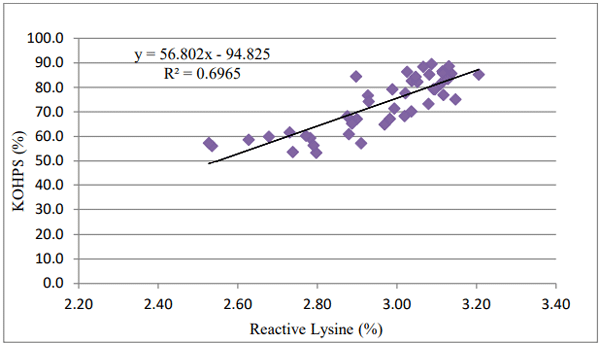

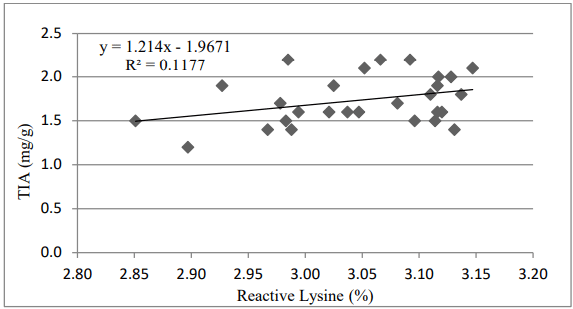
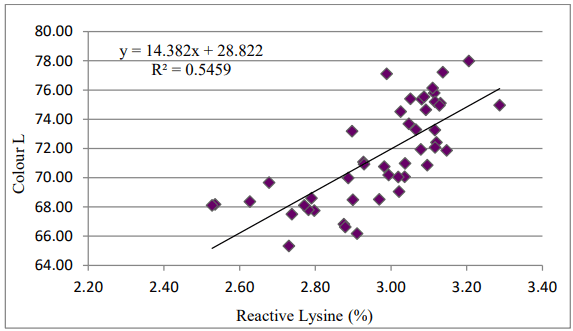
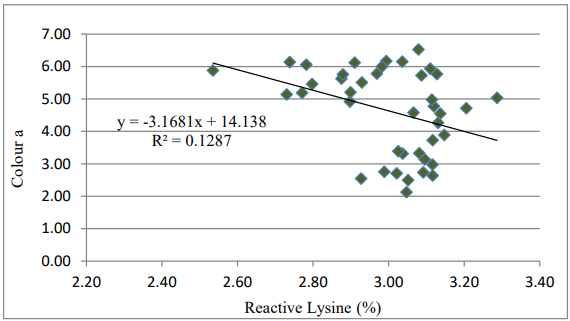
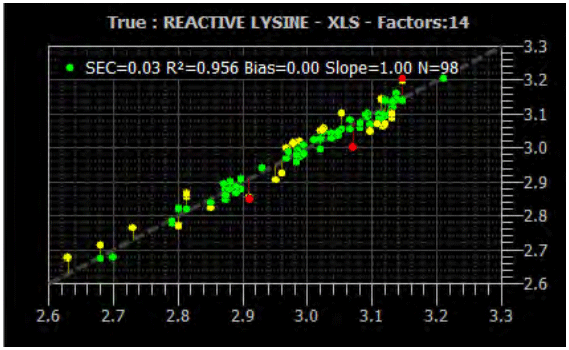
Presented at the 34th Annual Australian Poultry Science Symposium 2023. For information on the next edition, click here.
American Soybean Association (ASA) Soybean Meal Quality Handbook.
Araba M & Dale NM (1990) Poultry Science 69: 76-83
AOCS. American Oil Chemists’Society. Official Methods and Recommended Practices 13: Ba 12-75.
AOCS. American Oil Chemists’Society. Official Methods and Recommended Practices 13: Ba 10b-09.
AOAC International (2007) 982.30 E
Cresswell D & Swick RA (2008) Soybean Meal Quality Conference August, 2008. The Landmark Hotel, Bangkok.
Dong M, Tekliye M & Pei X (2019) International Journal of Agricultural Science and Food Technology 5: 64-67.
Hirai RA, Mejia L, Coto C, Caldas J, McDaniel CD & Wamsley KGS (2020) Journal of Applied Poultry Research 29: 600-621.
Kim JC, Mullan BP & Pluske JR (2012) Journal of Animal Science 90: 137-139.
Kim JC & Mullan BP (2013) Report on further development of a reactive lysine NIR calibration for soybean meal 4B-110.
Neoh SB & Ng LE (2006) Australian Poultry Science Symposium 18: 79-82.
Neoh SB (2008) Soybean Meal Quality Conference August, 2008. The Landmark Hotel, Bangkok.
Pahm AA, Pedersen C & Stein HH (2008) Journal of Agricultural and Food Chemistry 56: 9441-9446.
I always like research related to the development or comparison of methods for evaluating the quality of raw materials, because I am a biochemist. Reasonably selected methods for comparing a good conclusion, which can be used in the future by practitioners. Continue working according to the planned plan. I wish you Success.
Prof. V. S. Kryukov


United States







